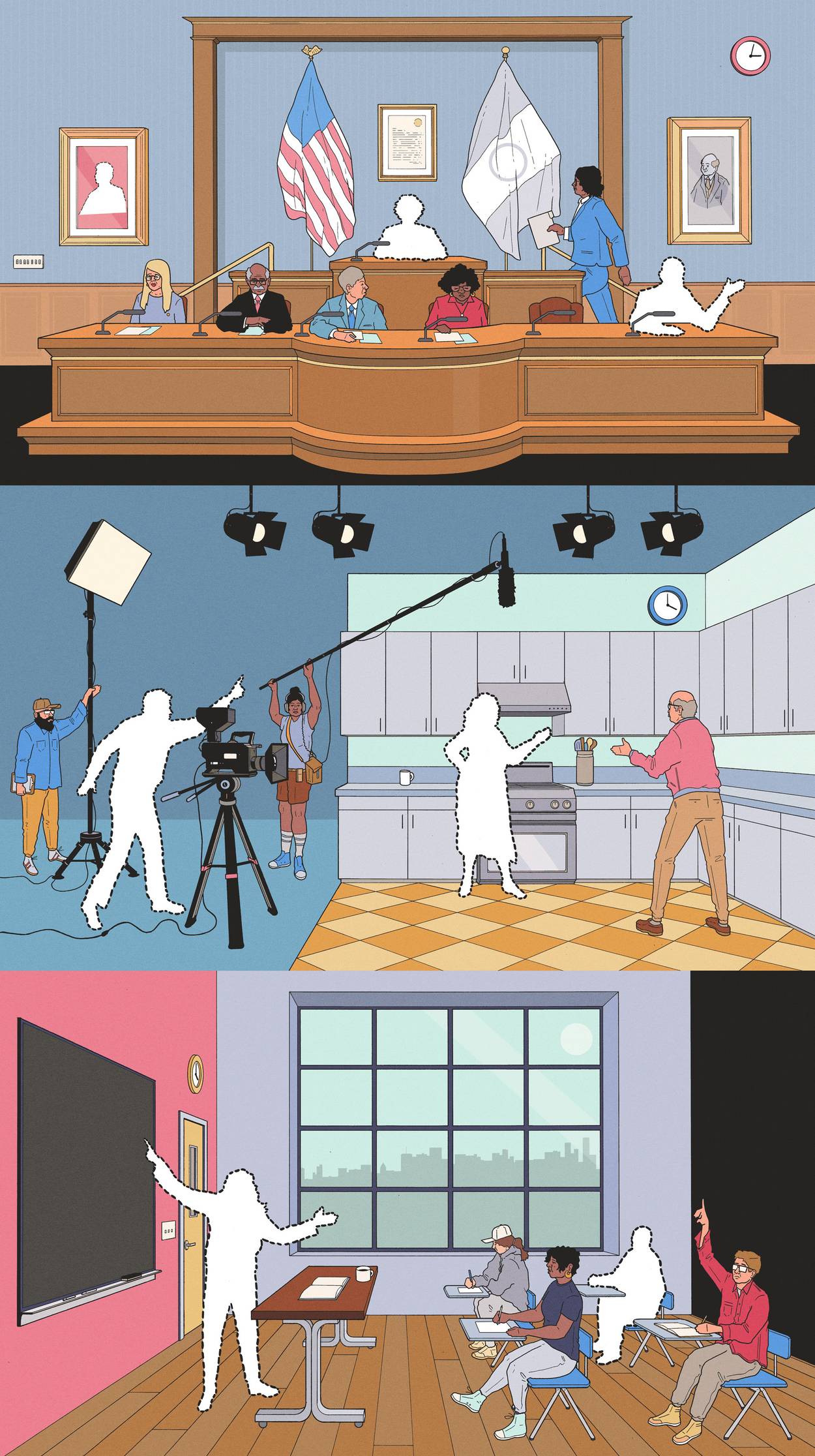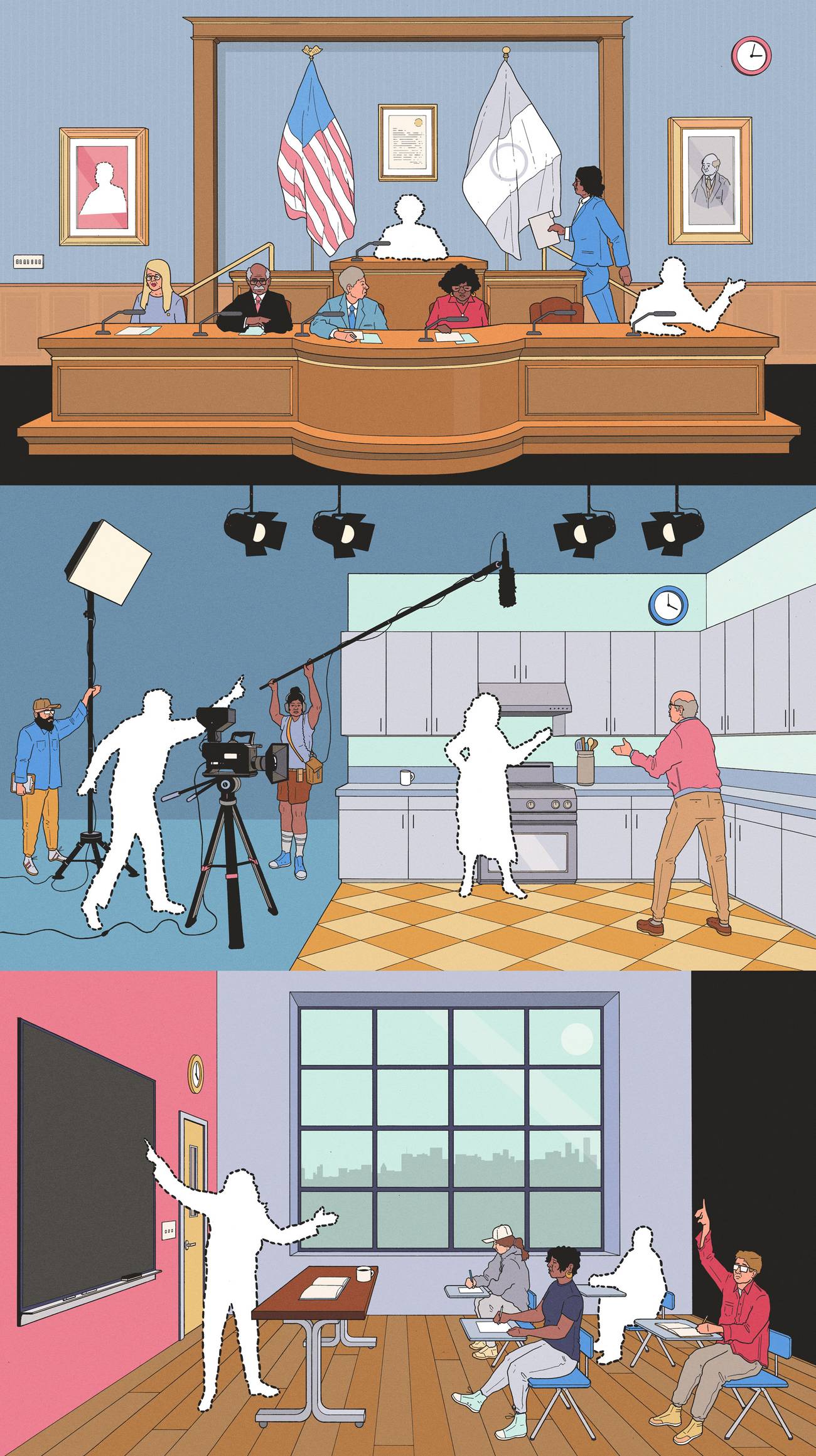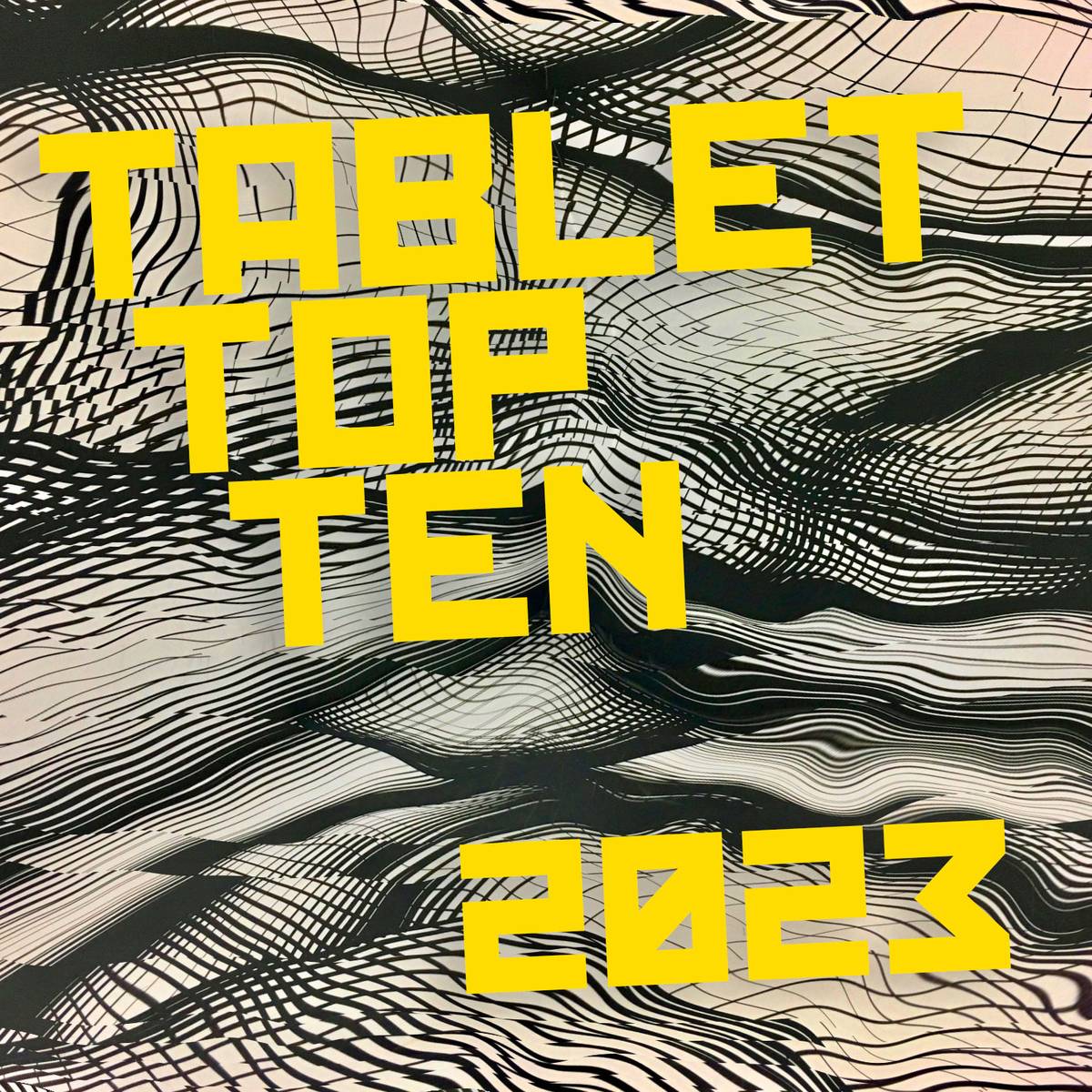The Vanishing
The erasure of Jews from American life




Suddenly, everywhere you look, the Jews are disappearing.
You feel it like a slow moving pressure system, an anxiety of exclusion and downward mobility. Maybe you first noticed it at your workplace. Or maybe it hit when you or your children applied to college or graduate school. It could have been something as simple as opening up the Netflix splash page. It’s gauche to count but you can’t help yourself: In academia, Hollywood, Washington, even in New York City—anywhere American Jews once made their mark—our influence is in steep decline.
For many Jews, the first instinct is to look inward: We blame intermarriage, assimilation, the loss of the immigrant work ethic. This is, of course, a cope. Because the most significant cause of the decline isn’t Jews themselves, but that American liberalism, our civic religion, has turned on us. Where Jewish success was once upheld as a sign of America’s strength and progress over its prejudices, Jewish “overrepresentation” is again something to be solved, not celebrated.
A tenure-track humanities professor at a prestigious public university tells of the finalists for her department’s next graduate school cohort. Of the 20 or so candidates, four to five are Jews. One is a working-class yeshivish applicant with an incredible backstory and even better recommendations. He is passed over for not being “diverse” enough. Of course our professor doesn’t complain— her own tenure is at risk. In the end, not a single Jew is offered admission.
Another Jewish professor applies to work in the UC system. In his mandatory diversity statement, which he describes as “the most shameful piece of writing I’ve ever done,” his sole aim is to convey the impression that he hopes to be the last Jewish man they ever hire. He still doesn’t get the job.
And why would he? Using YouGov data, Eric Kaufmann finds that just 4% of elite American academics under 30 are Jewish (compared to 21% of boomers). The steep decline of Jewish editors at the Harvard Law Review (down roughly 50% in less than 10 years) could be the subject of its own law review article.
The same pattern holds across America’s elite institutions: a slow-moving downward trend from the 1990s to the mid-2010s—likely due to all sorts of normal sociological factors—and then a purge so sweeping and dramatic you almost wonder who sent out the secret memo.
Museum boards now diversify by getting Jews to resign. A well-respected Jewish curator at the Guggenheim is purged after she puts on a Basquiat show. At the Art Institute of Chicago, even the nice Jewish lady volunteers are terminated for having the wrong ethnic background. There’s an entire cottage industry of summer programs and fellowships and postdocs that are now off-limits to Jews.
In 2014 there were 16-20 Jewish artists featured at the Whitney Biennial. After a very public campaign against a Jewish board member with ties to the Israeli defense establishment, the curators got the message. The 2022 biennial featured just 1-2 Jews.
Comb through the dozens of Jewish names for the 2012 Guggenheim Fellowship (I count 30-40). You’ll have a much harder time finding them 10 years later (14-16).

From 2010 through 2019 there were at least three Jews in every MacArthur Fellowship class, sometimes as many as five or six. The Forward would write effusive columns celebrating the year’s Jewish geniuses. Since 2020, just 0-1 Jews a year have been awarded grants. The Forward hasn’t bothered to take note.
Today American Jews watch with Solomonic bemusement as Students for Fair Admissions v. Harvard is argued before the Supreme Court. On some level we sympathize with the Asian American plaintiffs, who are suing Harvard for using admissions criteria that discriminate against them on the basis of their race. Maybe they really are the new Jews, facing the same barriers—insidious racism, personality scores, rural geographic preferences—that we once did.
On the other hand, fancying ourselves to be high caste members of a beneficent elite, we pretend not to notice that “diversity, equity, and inclusion” is a cudgel used to exclude certain groups of Americans, including Asians and Jews. Desperate to maintain their waning status within the liberal coalition, Jewish communal organizations ignore these contradictions. Once a protector of specifically Jewish interests but now secure in its new role as handmaiden to power, the Anti-Defamation League filed an amicus brief—in support of Harvard.
In the 1940s, the ADL took a different tack. For decades unofficial quotas at most Ivy League universities limited Jews to around 10% of the student body, despite evermore qualified Jewish applicants. Jewish organizations made it their mission to break this invisible barrier and by the end of the 1950s the quotas were a dead letter. The long summer of American Jewish success had begun.
But the seasons always change. A FIRE/Yougov survey found that self-identified Jews now number just 7% of Ivy League students, compared to 10% during the height of the antisemitic quotas.
In his gripping podcast Gatecrashers, about the history of Jews in the Ivy League, Mark Oppenheimer describes the troubled state of Jewish campus life. Harvard has gone from being 25% Jewish in the 1990s and 2000s to under 10% today. “In theory it could be the case that Jews are the same percentage of whites at Harvard as they always were,” he explains. “But Harvard has not shrunk the number of athletes it admits […] and they’ve kept their geographical diversity. So if you’re a Jewish kid who’s not an athlete and not a legacy and not from Wyoming … then there’s not much room left for you.”
According to the Hillel College Guide, Penn’s Jewish population declined from 26% in 2015 to 17% in 2021; NYU’s dropped from 24% to 13%. Princeton, Columbia, and Cornell have seen smaller but significant declines (Brown and Dartmouth, with different institutional priorities, are by all accounts happy exceptions).
Data from the Yale Chaplain’s Office—which appears to be the only Ivy League university that still tracks religious affiliation—shows a similar trend: The Jewish population went from 19.9% in the 2000s to 16.4% in the 2010s. A couple of years ago, the school’s chaplain told Meir Chaim Posner, the Chabad rabbi at Yale, that around 11% of Yale undergraduates were Jewish. “It’s dropped slightly since then,” Rabbi Posner told me in November.
“The university has decided that DEI is the overarching principle of admissions,” one Hillel director told me. “There’s a general consensus that it’s more difficult for Jewish students to get into top tier schools.” Nor is this difficulty confined to secular Jews—the modern Orthodox population has also crashed. A college counselor at a top Jewish day school reports that as universities have revamped enrollment and gone test-optional, the number of Orthodox students has decreased. “Every year has been harder,” he said. “Our ability to thoughtfully predict the likelihood of admission has gone way down.”
An uneasy omertà settles in. The Ivies skip college nights at Jewish day schools they visited for decades. At Penn there used to be two daily minyans—now there’s one. There are hushed whispers that if current trends hold, some of these colleges might no longer be able to support an Orthodox community at all.
The 1999 Hillel College Guide now reads like a map to a lost civilization. Harvard and Yale have 1,500 Jewish undergrads apiece. There are 5,000 Jewish students and grad students at Columbia, 6,000 at Penn, 14,000 at NYU. It’s hard to imagine that as recently as 2008, articles were being written about the “race” to attract Jewish students.
What was normal less than two decades ago sounds like a siren call from a distant golden age. To even suggest that a 15%-20% Jewish undergraduate student body might be acceptable in a country in which Jews make up 2.4% of the total population is anathema in today’s liberal society.
The 1999 Hillel College Guide now reads like a map to a lost civilization.
In New York—the seat of American Jewish political power—there are almost no Jews left in power. A decade ago the city had five Jewish congressmen, a Jewish mayor, two Jewish borough presidents, and 14 Jewish City Council members. Today just two congressmen and a single borough president remain. Only six Jews now sit on the 51-person City Council. Shelly Silver, the corrupt Orthodox former State Assembly leader, was replaced by Yuh-Line Niou, a pro-BDS “progressive” whose oligarch father was featured in the Panama Papers. Not even the Lower East Side Tenement Museum is recognizably Jewish anymore.
“What you have is a lack of identity of Jews as Jews,” the Democratic political consultant Hank Sheinkopf told The Washington Post. “And they don’t have the power to ensure that there’s more than one Jewish congressman. It’s astounding.”
Younger Jews are being excluded from the liberal organizations their parents and grandparents helped create. Identitarian meltdowns roil the progressive world. The Women’s March, the ACLU, and the SPLC all get rid of Jewish leadership. There will be no more “Mighty Iras” in our lifetime. Not even the Jewish president of the Audubon Society is safe.
There are still powerful Jews in Washington—neo-Nazis on Twitter like to post photos of Biden’s cabinet—but the influence is waning. Is it a coincidence that in the U.S. Senate (a handsy group of old men if ever there was one) the only senator forced to resign during the #MeToo panic happened to be Jewish? Or that activists pushed for Dianne Feinstein’s resignation for the explicit reason that she be replaced by someone who isn’t Jewish?
Of the 114 federal judges appointed by Joe Biden (as of this writing), just 8-9 appear to be Jewish—in a field that’s historically been at least 20% Jewish. Liberals worship Ruth Bader Ginsburg as a magical Jewish Teletubby, but they wouldn’t dare nominate another “white woman” to the highest court anytime soon. We are back to the single Jewish seat on the court.
Apparently Jews have so much power and influence that the highest-ranking Jewish senator in history finds it too politically difficult to hire a 22-year-old version of himself. There were at least 15 Jews on Chuck Schumer’s staff of 64 in 2014. After facing pressure for not being diverse enough, and despite an enlarged staff of 89, he can no longer make a minyan.
In Los Angeles—America’s second most Jewish city—there are now just two Jewish City Council members, down from six in 2000. In last year’s infamous dustup, Nury Martinez, the sharp-tongued council president, had despicable things to say about Black people, Oaxacans, even Armenians—but Jews were barely a footnote. “Judíos cut their deal with South LA,” she said. “They are gonna screw everybody else.”
It’s gauche to count but you can’t help yourself: In academia, Hollywood, Washington, even in New York City—anywhere American Jews once made their mark—our influence is in steep decline.
Speaking of LA, a decade ago there were 22 Jews on The Hollywood Reporter’s annual list of the Top 50 Showrunners. In 2022, that’s down to 13. Other than the half-Jewish (and already famous) Maggie Gyllenhaal, you’d have to go back six years to find a single Jew on Variety’s annual list of 10 Directors to Watch.
Thanks to the odious new Hollywood house style that requires a detailed ethnic and racial classification at the top of all capsule biographies, we can see just how many self-identified Jews are in the Sundance writers and directors labs, or the NBC, Paramount, and Disney writers and apprenticeship programs—it is zero. It seems not being Jewish is actually a primary qualification. So much for Jewish control of Hollywood.
The decline is so rapid—and the golden age so close to living memory—it’s a running joke. On the latest season of Curb Your Enthusiasm, Larry David meets with a group of younger non-Jewish studio executives to convince them to cast a Mexican American girl as Young Larry’s Jewish love interest. On Reboot, Steve Levitan’s Hulu show, an old guard of Jewish sitcom writers clash uncomfortably with their younger and woker—and noticeably non-Jewish—colleagues.
Not even Hollywood’s Jewish history belongs to Jews anymore. The new Academy Museum, dedicated to “radical inclusivity” and paid for with Haim Saban’s Jewish money, couldn’t bring itself to include Hollywood’s Jewish founders. In Babylon, Damian Chazelle’s epic flop about Hollywood’s golden age, the director follows an ahistorical Mexican studio executive and an Asian American lesbian rather than any of the very real Jewish moguls or screenwriters or directors of the era. What’s telling isn’t that Chazelle ignored Jews (anyone can do that) but that not a single reviewer bothered to notice this “erasure.” The culture has moved on.
What remains of Jewish Hollywood lives on borrowed time. Spielberg can make his Fabelmans, James Gray his Armageddon Time, but only because these are nostalgia pieces. Soon there will be no more RBG’s, no more Spielbergs, just a few off-brand Seinfelds doing a heritage act. There will certainly never be another Larry King or Andy Borowitz, Jews of such astounding mediocrity you wonder what was in the water.
In the 1950s, after Stalin’s death, after the purges, the Politburo turned to another pressing issue: the overrepresentation of Jews in Soviet life. Proportional representation (3% Tajik! 2% Uzbek! 12% Ukrainian!) became official policy, and the next decade saw the quick erosion of the Jewish nomenklatura. Soviet Jews—who had disproportionately contributed to and benefited from the building of the communist state—had outlived their usefulness.
A 1964 New York Times article explained that because Soviet republics assigned a certain number of students “preferential admission” based on their nationalities, other nationalities—aka Jews—were excluded. “A higher percentage of Jewish students was permitted to attend universities in Czarist Russia than is enrolled in the USSR today,” an outraged American Jewish Congress declared. “The 8.2% of university graduates who are Jews contrasts sharply with the present Jewish university enrollment of 3.22%.”
As true believers in the postwar liberal project, American Jews spent decades advocating for tolerance and equality of opportunity, not least because we were the prime beneficiaries. The ADL didn’t fight the quotas in the 1950s so Jews could matriculate in proportion to their percentage of the population. But there’s a tension between meritocracy and representation. The new DEI regime treats any disparity between groups as evidence of unfair advantage—and yet we’re supposed to think it’s a coincidence that Jewish representation plummets at the exact moment America frantically pushes to racially rebalance all high-status industries.
Because what is framed as a backlash against America’s “white” centers of power is in many cases a clever sleight of hand. Jews are being disproportionately purged from liberal institutions because Jews disproportionately exist within those institutions.
When activists and journalists and executives talk about how Broadway or NPR or publishing is “too white,” what they really mean is “too Jewish.” When The New York Times says it wants to make its internal demographics look more like New York City’s (excepting the Hasidim, of course), what this means is “fewer Jews.” Twenty years ago, if Pat Robertson spoke along these lines—making the same complaints about the same people and industries and institutions—there would have been a rush to condemn it as antisemitic. Today it passes for social justice.
In the 1960s and ’70s, facing hard barriers to their professional advancement, Soviet Jews lost the faith. The children and the grandchildren of the revolution tried to emigrate. When the authorities wouldn’t let them, American Jews rallied to their cause, created brand-new communal organizations, petitioned Congress, rallied thousands-strong outside the United Nations. Ours was a community confident in its power and confident in its future.
Asian Americans have the dignity of looking at admissions practices and demanding fair representation. The Jews, as ever, are a people apart. From civil rights to Vietnam to the spectacular bounty of their cultural and political achievements, liberal Jewish boomers always managed to be on the right side of history. It is a supreme irony that they’ve helped empower a movement that now places their children and grandchildren on the wrong side.
If Putin or Orban reduced their universities’ Jewish populations by 50%, the ADL would be howling. But Harvard and Yale can magically lose nearly half their Jewish students in less than a decade and we’ll take it on the chin. That this is occurring with the full acquiescence of a terrified liberal Jewish establishment should tell you just how much power Jews in America still have.
A previous version of this article mistakenly asserted that there were no Jewish Marshall Scholars in 2022.
Jacob Savage is a writer living in Los Angeles.